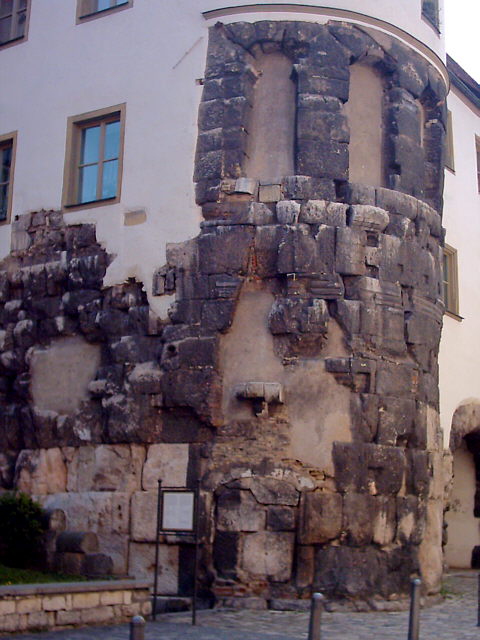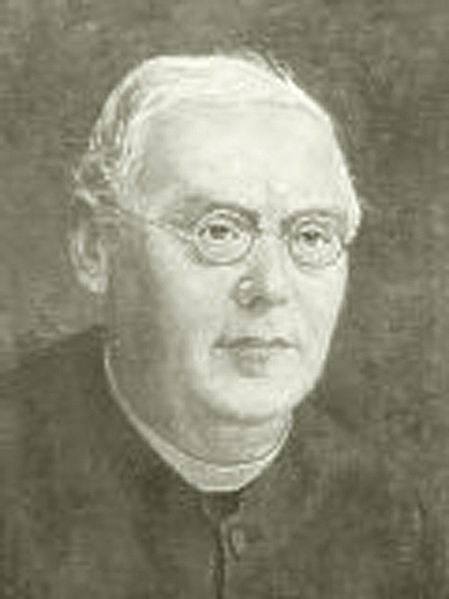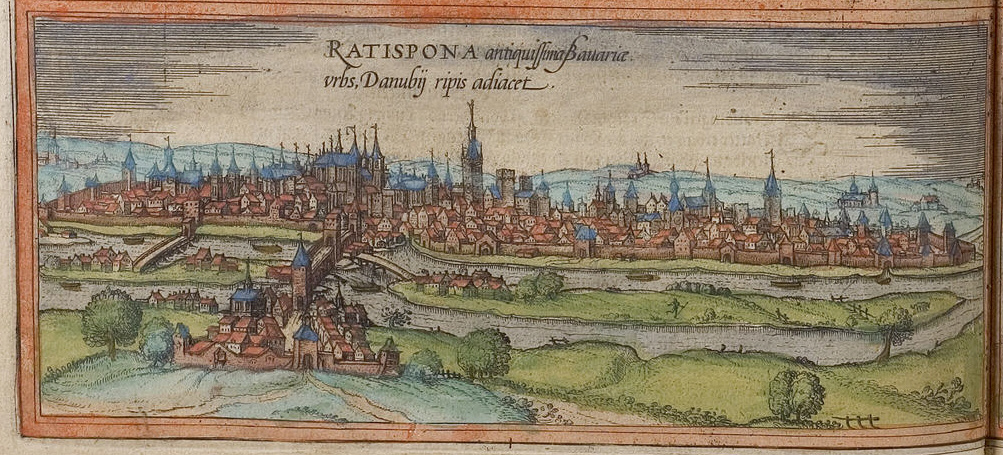|
Friedrich Pustet
Friedrich Pustet GmbH & Co. KG, known as Pustet, is a German publishing house located in Regensburg specializing in scientific literature, particularly in the fields of history and theology. Apart from publishing, Pustet operates a book printing firm and a chain of company-owned book stores across Germany. Pustet further publishes a range of academic journals and scholarly series in collaboration with, among others, the University of Regensburg, the Ludwig Maximilian University of Munich and the University of Augsburg. History The original home of the Pustet family was the Republic of Venice, where the name Bustetto is common. Presumably in the seventeenth century, the founder of the Ratisbon line immigrated to South Germany, where one of his descendants, Anton Pustet, lived as a poor bookbinder in the Lower Bavarian borough of Hals (near Passau) at the close of the eighteenth century. To him and his wife Anna (née Scheuerocker) was born on 25 March 1798, a son, Friedrich Pust ... [...More Info...] [...Related Items...] OR: [Wikipedia] [Google] [Baidu] |
Regensburg
Regensburg (historically known in English as Ratisbon) is a city in eastern Bavaria, at the confluence of the rivers Danube, Naab and Regen (river), Regen, Danube's northernmost point. It is the capital of the Upper Palatinate subregion of the state. With more than 150,000 inhabitants, Regensburg is the List of cities in Bavaria by population, fourth-largest city in the State of Bavaria after Munich, Nuremberg and Augsburg and the eighth-largest of all List of cities and towns on the river Danube, cities on the river Danube. From its foundation as an imperial Roman river fort, the city has been the political, economic and cultural centre of the surrounding region. Later, under the rule of the Holy Roman Empire, it housed the Perpetual Diet of Regensburg. The medieval centre of the city was made a UNESCO World Heritage Site in 2006 because of its well-preserved architecture, being the biggest medieval city site north of the Alps, and the city's historical importance for assembli ... [...More Info...] [...Related Items...] OR: [Wikipedia] [Google] [Baidu] |
Theology
Theology is the study of religious belief from a Religion, religious perspective, with a focus on the nature of divinity. It is taught as an Discipline (academia), academic discipline, typically in universities and seminaries. It occupies itself with the unique content of analyzing the supernatural, but also deals with religious epistemology, asks and seeks to answer the question of revelation. Revelation pertains to the acceptance of God, gods, or deity, deities, as not only transcendent or above the natural world, but also willing and able to interact with the natural world and to reveal themselves to humankind. Theologians use various forms of analysis and argument (Spirituality, experiential, philosophy, philosophical, ethnography, ethnographic, history, historical, and others) to help understanding, understand, explanation, explain, test, critique, defend or promote any myriad of List of religious topics, religious topics. As in philosophy of ethics and case law, arguments ... [...More Info...] [...Related Items...] OR: [Wikipedia] [Google] [Baidu] |
Editio Typica
An ''editio typica'' (Latin for typical edition) is a form of text used in the Catholic Church as an official source text of a particular document—typically in Eccelesiastical Latin—and used as the basis for all subsequent translations into vernacular languages Language is a structured system of communication that consists of grammar and vocabulary. It is the primary means by which humans convey meaning, both in spoken and signed forms, and may also be conveyed through writing. Human language is ch .... References {{RC-document-stub Catholic Church organisation ... [...More Info...] [...Related Items...] OR: [Wikipedia] [Google] [Baidu] |
Roman Curia
The Roman Curia () comprises the administrative institutions of the Holy See and the central body through which the affairs of the Catholic Church are conducted. The Roman Curia is the institution of which the Roman Pontiff ordinarily makes use in the exercise of his supreme pastoral office and universal mission in the world: thus curialism refers traditionally to an emphasis on the supreme authority of the Holy See within the Catholic Church. It is at the service of the Pope and Bishops in the Catholic Church, bishops, fulfilling their function with an Gospel, evangelical spirit, working for the good and at the service of Communion of saints, communion, unity and edification of the Universal Church and attending to the demands of the world in which the Church is called to fulfill its duty and mission (''Praedicate evangelium'', article 1). The structure and organization of responsibilities within the Curia are at present regulated by the apostolic constitution issued by Pope F ... [...More Info...] [...Related Items...] OR: [Wikipedia] [Google] [Baidu] |
Karl Ludwig Von Haller
Karl Ludwig von Haller (1 August 1768 – 20 May 1854) was a Swiss jurist, statesman and political philosopher. He was the author of ''Restauration der Staatswissenschaft'' (Restoration of Political Science, 1816–1834), a book which gave its namesake to the Restoration period after the Congress of Vienna, and which Georg Wilhelm Friedrich Hegel strongly criticized in §258 of ''Elements of the Philosophy of Right''. Von Haller's work, which was burnt during the Wartburg Festival, was a highly systematic defense both of the principles of dynastic legitimacy and monarchy founded on territorial lordship, as well as of pre-modern republics like those of the Swiss city-states, and considered one of the most consistent rejection of modern political ideas of the social contract, public law, and state sovereignty. Life Early life Von Haller was a son of Bern statesman and historian Gottlieb Emanuel von Haller, and grandson of poet and polymath Albrecht von Haller. His lineage desc ... [...More Info...] [...Related Items...] OR: [Wikipedia] [Google] [Baidu] |
Franz Xaver Haberl
Franz Xaver Haberl (12 April 1840, in Oberellenbach (today Mallersdorf-Pfaffenberg), Lower Bavaria – 5 September 1910, in Ratisbon) was a German musicologist, friend of Liszt, Perosi, and Singenberger, cleric, and student of Proske. Biography Haberl made his classical and theological studies at Passau, Bavaria, where he was ordained priest, 12 August 1862. Showing decided aptitude for music, he was given every opportunity for study of the art, and was entrusted with the direction of music in the seminary. From 1867 to 1870 Haberl resided in Rome, where he was active as choirmaster at the German national church, Santa Maria dell'Anima, and also made historical and archæological researches. From 1871 to 1882 he directed the choir at the Ratisbon cathedral. Working for church music reform, in 1874 Haberl founded a school for church musicians at Regensburg (Ratisbon). This school began with three professors— Haberl, Georg Jakob, and —and only three pupils, an ... [...More Info...] [...Related Items...] OR: [Wikipedia] [Google] [Baidu] |
Franz Xaver Witt
Franz Xaver Witt (February 9, 1834 – December 2, 1888) was a Catholic priest, church musician, and composer. He was a leading figure in the Cecilian movement for the reform of Catholic church music in the second half of the 19th century.Williamson, John, 2004, '' The Cambridge Companion to Bruckner'', Cambridge University Press, p 57 & 267, . Witt was born in Walderbach, Bavaria. His father was a school teacher. Witt was taught piano and singing from a young age. He studied theology and science at the seminary in Regensburg. He sang in the seminary's choir, which was under the direction of Joseph Schrems.Catholic Encyclopedia He was ordained as a priest in 1856 and taught Gregorian chant at the seminary at Regensburg. In 1867 was appointed inspector of the seminary of St. Emmeram.Randel, Don Michael, 1996, ''The Harvard Biographical Dictionary of Music'', Harvard University Press, p. 991, . In 1868 Witt founded the Caecilia Society in order to revive the use of Gregorian cha ... [...More Info...] [...Related Items...] OR: [Wikipedia] [Google] [Baidu] |
Karl Proske
Karl Proske (11 February 1794, Gröbnig (Upper Silesia) – 20 December 1861), was a German Catholic cleric, also known as Carolus Proske and Carl Proske. Life In his youth, Proske was a medical doctor, and worked for the Prussian military during the 1813-15 engagement. In 1821 he entered the seminary, and was ordained in Regensburg on April 11, 1826. The following year, he was made a vicar choral of Regensburg Cathedral, a post he held for the rest of his life. In 1830 he was made Canon and Kapellmeister of Regensburg cathedral. Musical work In addition to his duties as a cleric, Proske devoted all his energies and spent his entire private income on the restoration of what he called "vere musica ecclesiae," the "true music of the Church." This he considered to be the ancient Gregorian chant and especially the polyphonic works of the Renaissance masters (such as Palestrina, Nanini, Marenzio, Lassus, etc.). He searched all throughout Germany and Italy, making many trip ... [...More Info...] [...Related Items...] OR: [Wikipedia] [Google] [Baidu] |
Liturgical
Liturgy is the customary public ritual of worship performed by a religious group. As a religious phenomenon, liturgy represents a communal response to and participation in the sacred through activities reflecting praise, thanksgiving, remembrance, supplication, or repentance. It forms a basis for establishing a relationship with God. Technically speaking, liturgy forms a subset of ritual. The word ''liturgy'', sometimes equated in English as " service", refers to a formal ritual enacted by those who understand themselves to be participating in an action with the divine. Etymology The word ''liturgy'' (), derived from the technical term in ancient Greek (), ''leitourgia'', which means "work or service for the people" is a literal translation of the two affixes λήϊτος, "leitos", derived from the Attic form of λαός ("people, public"), and ἔργον, "ergon", meaning "work, service". In origin, it signified the often expensive offerings wealthy Greeks made in servi ... [...More Info...] [...Related Items...] OR: [Wikipedia] [Google] [Baidu] |
Passau
Passau (; ) is a city in Lower Bavaria, Germany. It is also known as the ("City of Three Rivers"), as the river Danube is joined by the Inn (river), Inn from the south and the Ilz from the north. Passau's population is about 50,000, of whom about 12,000 are students at the University of Passau, renowned in Germany for its institutes of economics, law, theology, computer science and cultural studies. History In the 2nd century BC, many of the Boii tribe were pushed north across the Alps out of northern Italy by the Romans. They established a new capital called Boiodurum by the Romans (from Gaulish ), now within the Innstadt district of Passau. Passau was an ancient Rome, ancient Roman colony called Batavis, Latin for "for the ''Batavi''". The Batavi (Germanic tribe), Batavi were an ancient Germanic tribe from area of the Rhine delta who frequently served in the Roman army as auxiliary troops. ''Batavis'' (Passau-Altstadt) was a Roman castrum in the province of Raetia, while a ... [...More Info...] [...Related Items...] OR: [Wikipedia] [Google] [Baidu] |
Ratisbon
Regensburg (historically known in English as Ratisbon) is a city in eastern Bavaria, at the confluence of the rivers Danube, Naab and Regen, Danube's northernmost point. It is the capital of the Upper Palatinate subregion of the state. With more than 150,000 inhabitants, Regensburg is the fourth-largest city in the State of Bavaria after Munich, Nuremberg and Augsburg and the eighth-largest of all cities on the river Danube. From its foundation as an imperial Roman river fort, the city has been the political, economic and cultural centre of the surrounding region. Later, under the rule of the Holy Roman Empire, it housed the Perpetual Diet of Regensburg. The medieval centre of the city was made a UNESCO World Heritage Site in 2006 because of its well-preserved architecture, being the biggest medieval city site north of the Alps, and the city's historical importance for assemblies during the Holy Roman Empire. In 2014, Regensburg was among the top sights and travel attractio ... [...More Info...] [...Related Items...] OR: [Wikipedia] [Google] [Baidu] |










